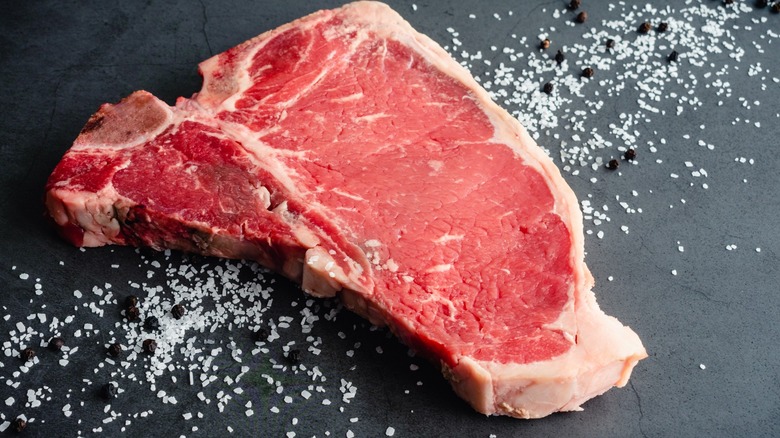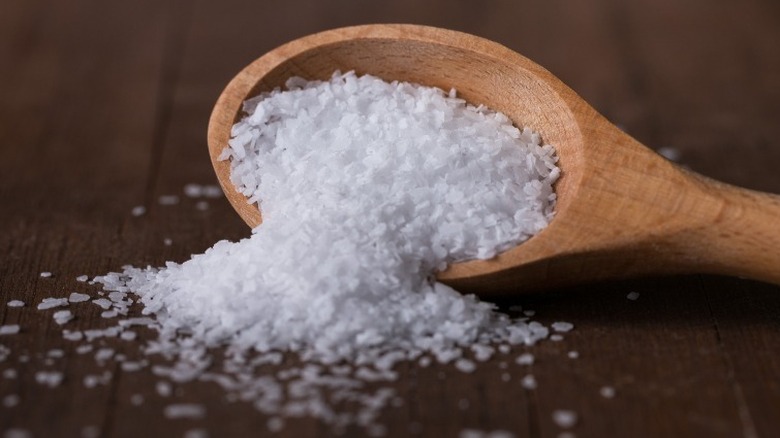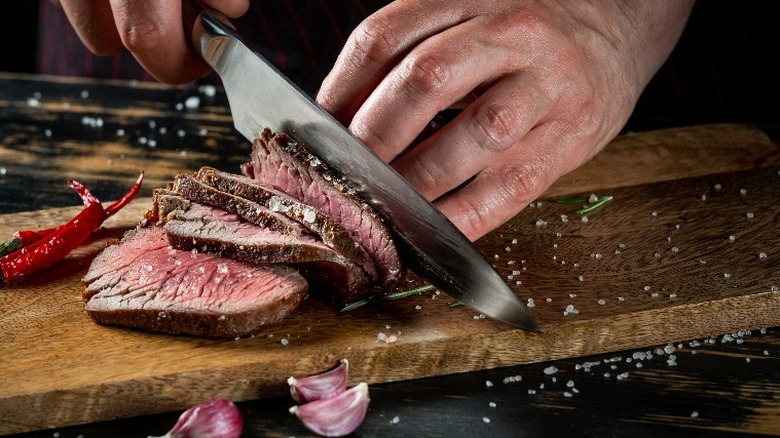Kosher Salt Is The End-All, Be-All Of Perfect Steaks
Steaks usually don't need a whole lot of seasoning, but the one necessity for all cuts, whether they're prime quality or on the cheaper side, is salt. While a good steak will shine without many other additives, salt is essential in tenderizing the meat and bringing out its internal flavors. In other words, salt enhances the natural flavor of the steak rather than masking its notes. Specifically, kosher salt is the preferred variety of sodium to season a steak with due to its larger crystals that more readily extract flavor than the tiny, fine particles in a table salt shaker.
In fact, kosher salt is usually the general choice of restaurant chefs due to the delicate way it enhances moisture in a recipe. The wider surface area of the grains means that they sit atop meats, drawing out flavors from within instead of penetrating inside. The powdered consistency of table salt tends to quickly dissolve, sinking deep inside and oversalting the delicate meat. Table salt also usually contains iodine, a harmless and, in fact, a necessary nutrient, but also one that can make your food taste slightly metallic. Besides, you can always get iodine through other means like eggs, fish, and dairy.
How is kosher salt different than other salts?
The origin of the term "kosher salt" traces back to its role in the age-old Jewish tradition of koshering, a method of preparing meat for eating. It's more similar to sea salt than table salt due to its coarser material, though kosher salt often comes from salt mines and not necessarily directly from the sea. Kosher salt is also more consistently larger than sea salt grains, which usually vary in size somewhere in between kosher and table salts. Coarse sea salt makes for a nice brine, but plain kosher salt is still preferable for seasoning steaks.
The pink-colored Himalayan salt is another variety that has gained popularity in recent years due to its proposed health benefits. Although there is absolutely no evidence to suggest that these crystals are any better for you than other types of salt, it does look pretty on top of food as a finishing salt, especially if ground into a coarser texture that lets the pink hues pop out more. Once again, however, kosher salt wins as the go-to steak seasoner.
How and when to season steak
As long as you use kosher salt, you shouldn't worry too much about oversalting your steak. Liberally sprinkle a generous layer of salt on top, enough so that you can physically see a saline layer on every surface, including the sides. Remember to add black pepper to the mix, too. You don't have to pound your steak after you season it, especially if it's a nice one, but do pat it a bit so that everything infuses together nicely. Allow the steak to rest for approximately 30 to 40 minutes at room temperature while you do some other prep work like firing up the grill or making side dishes.
Once you've seared the steak, it may be beneficial to salt it even more to create a nice, ever-so-slightly crunchy outer layer. In fact, you may want to go even bigger than kosher salt, using salt flakes instead of crystals. If you're hesitant about using even more salt, cut a piece off to compare. You can even sprinkle more salt on after you've sliced up your steak.



